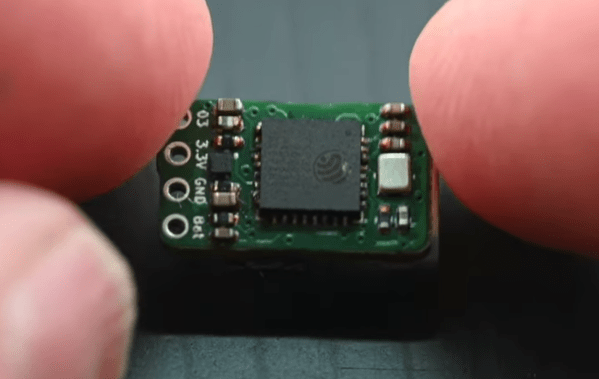When you really love your pawed, feathered, or scaled friends, you build projects for them. (Well, anyway, that’s what’s happened to us.) For the 2025 Pet Hacks Challenge, we asked you to share your favorite pet-related hacks, and you all delivered. So without further ado, here are our favorites, as well as the picks-of-the-litter that qualified for three $150 DigiKey gift certificates. Spoiler alert: it was a clean sweep for team cat.
challenge23 Articles
Shrinking Blinky As Far As Possible
Many of us know the basic Blink Arduino sketch, or have coded similar routines on other microcontrollers. Flashing an LED on and off—it doesn’t get much simpler than that. But how big should a blink sketch be? Or more importantly, how small could you get it? [Artful Bytes] decided to find out.
The specific challenge? “Write a program that runs on a microcontroller and blinks an LED. The ON and OFF times should be as close to 1000 ms as possible.” The challenge was undertaken using a NUCLEO-L432KC Cortex-M4 with 256 K of flash and 64 K of RAM.
We won’t spoil the full challenge, but it starts out with an incredibly inefficient AI & cloud solution. [Artful Bytes] then simplifies by switching to an RTOS approach, before slimming down further with C, assembly, and then machine code. The challenge was to shrink the microcontroller code as much as possible. However, you might notice the title of the video is “I Shrunk Blinky to 0 Bytes.” As it turns out, if you eliminate the digital code-running hardware entirely… you can still blink an LED with analog hardware. So, yes. 0 bytes is possible.
We’ve featured the world’s smallest blinky before, too, but in a physical sense rather than with regards to code size.
Crawler Challenge: Building Rope-Traversing Robots
Rope-climbing robots are the stuff of engineering dreams. As kids, didn’t we all clutter our family home with constructions of towers and strings – Meccano, or Lego – to have ziplines spanning entire rooms? Good for the youngsters of today, this has been included in school curricula. At the University of Illinois, the ME 370 students have been given the task of building a robot that can hang from a rope and walk across it—without damaging the rope. The final projects show not only how to approach tricky design problems, but also the creative solutions they stumbled upon.
Imagine a tiny, rope-climbing walker in your workshop—what could you create?
The project is full of opportunities for those thinking out of the box. It’s all about the balance between innovation and practicality: the students have to come up with a solution that can move at least 2 meters per minute, fits in a shoebox, and has some creative flair—no wheels allowed! The constraints provide an extra layer of challenge, but that’s where the fun lies. Some students use inverted walkers, others take on a more creature-like approach. The clever use of motors and batteries shows just how far simple tech can go when combined with a bit of engineering magic.
This project is a fantastic reminder that even small, seemingly simple design challenges can lead to fascinating creations. It invites us adults to play, and by that, we learn: a win-win situation. You can find the original article here, or grab some popcorn and watch the video below.
Continue reading “Crawler Challenge: Building Rope-Traversing Robots”
How Small Can The ESP32 Get?
At its core, the ESP32 chip is not much more than an integrated circuit, a huge mass of transistors sealed inside an epoxy resin package with some leads. Of course, most of us won’t buy discrete ESP32 chips with no support circuitry since it’s typically easier and often not that much more expensive to get them paired with development boards of some type for easy access to things like USB and GPIO. But these tiny chips need little in the way of support to get up and running as [Paul] demonstrates with this tiny ESP32 board.
The project started as a challenge for [Paul] to build the smallest ESP32 that would still function. That means carving away nearly everything normally found accompanying one of these chips. There is no charging circuitry, only one of the GPIO pins is accessible, and it even foregoes the WiFi antennas which eliminates the major reason most people would reach for this chip in the first place. But at this form factor even without wireless capabilities it still blows other chips of this stature, like the ATtiny series, out of the water.
Even though [Paul] built it as a challenge, it goes a long way to demonstrate what’s really needed to get one of these chips up and running properly. And plenty of projects don’t need a ton of I/O or Wi-Fi either, so presuming these individual chips can be found cheaply and boards produced for various projects its an excellent way to minimize size and perhaps even power requirements. You can make these boards even smaller than a USB-A connector if you want to take this process even further, too.
Congratulations To Our Op-Amp Challenge Winners!
The real world is analog, and the op-amp is the indispensable building block of many analog circuits. We wanted to give you analog fanatics out there a chance to shine and to encourage our digital brothers and sisters to dip their toes in the murky waters where ones and zeroes define the ends of a spectrum rather than representing the only choice. Hence, we presented the Op Amp Challenge. And you did not disappoint!
We received 83 entries, and it was extraordinarily hard to pick the winners. But since we had three $150 DigiKey shopping sprees to give away, our six judges buckled down and picked their favorites. Whether or not you’ve got the Golden Rules of the ideal op-amp tattooed on your arm, you’ll enjoy looking through all of the projects here. But without further ado…
The Winners
[Craig]’s Op Art is an X-Y voltage generator to plug into an oscilloscope and make classic Lissajous and other spirograph-like images, and it’s all done in analog. Maybe it was his incredible documentation, the nice use of a classic three-op-amp tunable oscillator, or the pun hidden in the title. Whatever the case, it wowed our judges and picked up a deserved place in the top three.
Hearkening back to the pre-digital dinosaur days, [Rainer Glaschick]’s Flexible Analog Computer is a modular analog computer prototyping system on a breadboard backplane. Since you have to re-wire up an analog computer for your particular, it’s great that [Rainer] gave us a bunch of examples on his website as well, including a lunar lander and classic Lorenz attractor demos.
And there was no way that [Chris]’s interactive analog LED wave array wouldn’t place in the top three. It’s a huge 2D analog simulation that runs entirely on op-amps, sensing when your hand moves across any part of its surface and radiating waves out from there. You have to admire the massive scale here, and you simply must check out the video of it in action. Glorious!
Continue reading “Congratulations To Our Op-Amp Challenge Winners!”
Analog Anoraks: The Op Amp Contest Starts Now!
We thought it was time to give the analog side of Hackaday their chance to shine, and what’s the quintessential analog IC? The op amp! Whether you’re doing tricky signal conditioning, analog computations like it’s 1960, or just making music sound good, op amps are at the heart of many designs. This contest, starting right now, is your chance to show off what you can do with a good op amp, or a few.
And for everyone else, here’s your chance to dip your toes into the warm analog waters. Whether you’ve always wanted to build a Chua’s chaos circuit or just to listen to music, there’s probably an op-amp project that will fit your personal bill. All you have to do to enter is set up a project on Hackaday.io, and use the pull-down menu to enter. We welcome shows of op-amp bravado, naturally, but we’re also stoked to see your simple projects that might help our digital friends leave their world of black and white, and enter into the shades of grey.
Thanks to Digi-Key, our sponsor for the challenge, there are three $150 shopping sprees on the line for the winners. And as always, there are some honorable mention categories to help whet your analog whistle, and to give us an excuse to feature a lot of great projects. You’ve got until June 6, to get your entry in, but these aren’t necessarily simple builds, so get going now.
Continue reading “Analog Anoraks: The Op Amp Contest Starts Now!”
Hackaday.io Low-Power Challenge Begins Today
How low can you go? The 2023 Hackaday.io Low-Power Challenge is about doing the most with the least juice – bang for the power-budget buck, if you get our drift. And with three $150 gift certificates from Digi-Key on the line, you’ll be able to keep your projects going forever. The Challenge runs until March 21st, but with low-power, the devil is often in the details, so get started today!
More and more projects need to run on their own power, and more often than not, that means getting by without access to a wall plug. This contest is to encourage your designs that run on solar, small batteries, and generally energy harvested from wherever you can get it. But the power generation mechanism is taking the back seat here – we want to see what you can do with a few good electrons. Surprise us with your maximum minimalism!
Continue reading “Hackaday.io Low-Power Challenge Begins Today”















